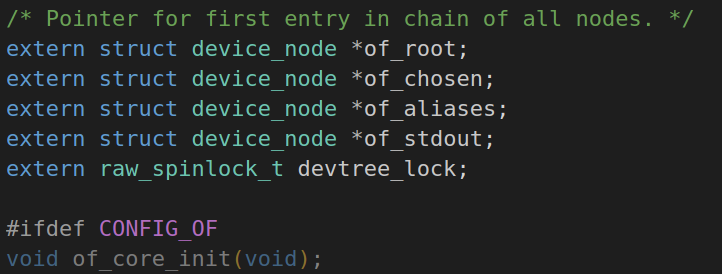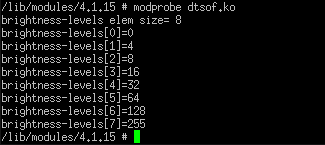这一章之前我们应该先大致了解一下设备树的基本信息和基础语法。这两点我就先不总结了,网上多的是。为了后续做设备树的使用,我们这一章讲一下如何在驱动中(内核态)获取设备树中对于设备的描述。
of函数
内核为我们提供了一组of函数,用来获取设备树节点中的详细信息。这个OF函数路径为在内核路径下单include/linux/of.c中。我们主要使用下面几种
- 查找节点
- 查找子/父节点
- 提取属性值
- 其他,例如查询属性是否包含指定字符的、直接获取内存映射信息的等等
注意一点:在内核中如果想要使用of函数,要在导入的of.h内进行配置,加上下面的代码
#ifdef CONFIG_OF
如下图所示

结合下面一段设备树的信息,我们来试下如何使用这些of函数
#include <dt-bindings/input/input.h> #include "imx6ull.dtsi" / { model = "Freescale i.MX6 ULL 14x14 EVK Board"; compatible = "fsl,imx6ull-14x14-evk", "fsl,imx6ull"; chosen { stdout-path = &uart1; }; memory { reg = <0x80000000 0x20000000>; }; reserved-memory { #address-cells = <1>; #size-cells = <1>; ranges; linux,cma { compatible = "shared-dma-pool"; reusable; size = <0x14000000>; linux,cma-default; }; }; backlight { compatible = "pwm-backlight"; pwms = <&pwm1 0 5000000>; brightness-levels = <0 4 8 16 32 64 128 255>; default-brightness-level = <6>; status = "okay"; }; }
我们主要想要获取根节点下面back-light的信息。
通过OF函数获取节点
节点(device_node)在of.h里是按照一个结构体被定义好的
struct device_node { const char *name; const char *type; phandle phandle; const char *full_name; struct fwnode_handle fwnode; struct property *properties; struct property *deadprops; /* removed properties */ struct device_node *parent; struct device_node *child; struct device_node *sibling; struct kobject kobj; unsigned long _flags; void *data; #if defined(CONFIG_SPARC) const char *path_component_name; unsigned int unique_id; struct of_irq_controller *irq_trans; #endif };
驱动操作硬件,主要是获取节点内的属性。而想要获取属性,首先要索引到该节点。这个device_node结构体就是被索引出来的节点对象。
比如我们需要操作设备树中backlight这个设备,因为我们有这个设备的名称(backlight),并且这个设备树是我们自己写的,所以路径也是明确的,我们只需要直接指定路径就可以了,就要用到下面的函数
static inline struct device_node *of_find_node_by_path(const char *path)
参数path就是要操作的节点路径,由于backlight是在根节点下面,就可以直接指定,所以这个函数是我们最长用到。但是如果我们不太清楚其具体路径,还有个通过指定名称来查找的
extern struct device_node *of_find_node_by_name(struct device_node *from, const char *name);
指针参数from是我们需要查找的起始路径,name就是我们要找到设备树名称。
此外还有几种不太常用的,在/include/linux/of.h文件中都能找到
#define for_each_of_allnodes_from(from, dn) \ for (dn = __of_find_all_nodes(from); dn; dn = __of_find_all_nodes(dn)) #define for_each_of_allnodes(dn) for_each_of_allnodes_from(NULL, dn) extern struct device_node *of_find_node_by_name(struct device_node *from, const char *name); extern struct device_node *of_find_node_by_type(struct device_node *from, const char *type); extern struct device_node *of_find_compatible_node(struct device_node *from, const char *type, const char *compat); extern struct device_node *of_find_matching_node_and_match( struct device_node *from, const struct of_device_id *matches, const struct of_device_id **match); extern struct device_node *of_find_node_opts_by_path(const char *path, const char **opts);
不太常用,这里就不再一一列举了。
获取父子节点
这个功能暂时还用不到,把头文件中的声明列出来,以后如果需要了再做完善
extern struct device_node *of_get_parent(const struct device_node *node); extern struct device_node *of_get_next_parent(struct device_node *node); extern struct device_node *of_get_next_child(const struct device_node *node, struct device_node *prev); extern struct device_node *of_get_next_available_child(const struct device_node *node,
struct device_node *prev); extern struct device_node *of_get_child_by_name(const struct device_node *node, const char *name);
不再说明具体用法。
获取节点属性
敲黑板!这段是重点!!!
我们要通过设备树来对应硬件写驱动,必须要拿到设备树里这些节点中指定键的值。根据值不同数据类型我们一步步来实现
字符串类属性获取
backlight属性中compatible(兼容性)属性的值时字符串类型
compatible = "pwm-backlight";
extern int of_property_read_string(struct device_node *np, const char *propname, const char **out_string);
参数np就是我们在前面拿到的节点结构体,propame就是属性,out_string就是要读取的数据,通过指针放到内存中。
#include <linux/module.h> #include <linux/kernel.h> #include <linux/init.h> #include <linux/fs.h> #include <linux/uaccess.h> #include <linux/io.h> #include <linux/types.h> #include <linux/cdev.h> #include <linux/device.h> #include <linux/of.h> #include <linux/of_address.h> #include <linux/of_irq.h> static int __init dtsof_init(void) { int ret = 0; struct device_node *dev_nd=NULL; const char *str; //获取节点 dev_nd = of_find_node_by_path("/backlight"); //找到backlight的节点,其路径为/backlight if(dev_nd==NULL){ ret = -EINVAL; return ret; goto fail_findnd; } //获取字符串类型属性 ret = of_property_read_string(dev_nd,"compatible",&str); if(ret<0) { goto fail_readstr; } else{ printk("read string status=%s\r\n",str); } return ret; fail_readstr: fail_findnd: return ret; } static void __exit dtsof_exit(void) { } module_init(dtsof_init); module_exit(dtsof_exit); MODULE_LICENSE("GPL"); MODULE_AUTHOR("ZZQ");
整个文件是以驱动的流程呈现的,通过module_init()将初始化函数dtsof_init注册,在加载模块以后,先获取backlight对应节点(dev_nd),再通过读取字符属性的函数将compatible属性值读取到str指向的内存中,最后通过printk打印至终端。修改make文件后编译生成ko文件。
将ko文件复制到rootfs路径下lib/modules/4.1.15下,加载模块,会直接打印出来(第一次加载模块一定注意先运行depmod一下!),就会有下面的效果

of函数在读取成功时返回值应该为0,否则返回值为负数,所以在程序中我加了个判定,如果有异常通过goto语句跳转至相应功能代码处(案例中不需要做相应动作,所以是空的。)
default-brightness-level = <6>;
要注意点是,这里我们读取的数值类型数据都是32位的,要用到下面的函数
static inline int of_property_read_u32(const struct device_node *np, const char *propname, u32 *out_value)
其中参数np还是device_node,propname是我们要读取的属性,后面的指针是指向到读取数据存储的内存地址
由于前面已经有了整个函数的架构,这里只把init函数放出来看下
static int __init dtsof_init(void) { int ret = 0; struct device_node *dev_nd=NULL; const char *str; //获取节点 dev_nd = of_find_node_by_path("/backlight"); //找到backlight的节点,其路径为/backlight if(dev_nd==NULL){ ret = -EINVAL; return ret; goto fail_findnd; } //获取字符串类型属性 ret = of_property_read_string(dev_nd,"compatible",&str); if(ret<0) { goto fail_readstr; } else{ printk("read string status=%s\r\n",str); } //获取数字类型属性 const u32 def_val; ret = of_property_read_u32(dev_nd,"default-brightness-level",&def_val); if(ret<0){goto fail_read32;} else{ printk("default-brightness-level=%d\r\n",def_val); } return ret; fail_read32: fail_readstr: fail_findnd: return ret; }
make一下复制到指定目录,启动开发板后加载模块

这样可以看到我们读取到数据了,整形数据,值为6!
数组类型数据读取
最后就是读取数组类型的数据,首先要用到下面的函数获取数组的长度
static inline int of_property_count_elems_of_size(const struct device_node *np, const char *propname, int elem_size)
注意那个elem_size是数组中每个元素的数据长度,我们可以直接用sizeof(u32)来指定
static inline int of_property_read_u32(const struct device_node *np, const char *propname, u32 *out_value)
参数device_node就是设备节点,propname为属性名称,最后的out_value是读取的数组存储的地方。
先演示一个稍微复杂的方法,使用这个函数时可以先使用kmalloc函数申请一块内存(记得导入头文件(/linux/slab.h)),把读到的数据放在这块内存中
static int __init dtsof_init(void) { int ret = 0; struct device_node *dev_nd=NULL; u8 i=0; u8 datasize; u32 *brival; //获取节点 dev_nd = of_find_node_by_path("/backlight"); //找到backlight的节点,其路径为/backlight if(dev_nd==NULL){ ret = -EINVAL; return ret; goto fail_findnd; } // 获取数组类型属性 datasize = of_property_count_elems_of_size(dev_nd,"brightness-levels",sizeof(u32)); if(ret<0){ ret = -EINVAL; goto fail_readele; } else{ printk("brightness-levels elem size= %d\r\n",datasize); } brival = kmalloc(datasize * sizeof(u32),GFP_KERNEL); //申请内存 if(!brival){ printk("buf err\r\n"); ret = -EINVAL; goto fail_mem; } //内存获取成功,获取数组 ret = of_property_read_u32_array(dev_nd,"brightness-levels",brival,datasize); if(ret<0){ printk("read array err\r\n"); goto fail_read32array; } else{ for(i=0;i<datasize;i++) {printk("brightness-levels[%d]=%d\r\n",i,*(brival+i));} } kfree(brival); return ret; fail_read32array: kfree(brival); //释放内存 fail_mem: fail_readele: fail_findnd: return ret; }
注意在使用kmalloc函数后如果成功申请了内存,在使用完成后要将该内存空间释放,有个和kmalloc成对的函数kfree,把申请的内存传递过去就可以了。make以后加载模块可以看出来读取到的值和数组。
这种方法要事先申请一段内存空间,也可以直接声明一个数组,把数组直接传给参数。但是用上面的方法有个优点就是如果我们不知道数组元素的个数,在声明变量的时候是无法定义数组大小的,那么就可以直接通过获取数组元素个数再通过这个值申请内存空间。直接定义数组的过程在下一章节会使用到!

有了上面的几个函数,后面我们就可以从最基础的点灯来演示一下了!